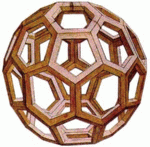 la hipótesis de Gaia
la hipótesis de Gaia
Definición: La hipótesis denominada Gaia por James Lovelock en 1976 se refiere a la superficie terráquea viva y a su ambiente circundante, considerados como proceso en evolución que constituye un suprasistema fuertemente acoplado. Sus sistemas constituyentes son la biota y su envolvente material, formada por atmósfera, océanos y rocas superficiales. Tanto en la biota como en su envolvente, aparecen importantes propiedades que se autorregulan. Son el clima y la composición química, por ejemplo, que - segun la hipótesis - surgen como variable dependiente del proceso evolutivo.
Esta hipótesis está inspirada en cómo son los organismos vivos y cómo son otros sistemas a lazo cerrado que se autorregulan. Sería de esperar que en esos sistemas apareciesen propiedades emergentes asociadas con el orden en vías de autoorganización. Dicho de otra manera, el total (el suprasistema) es más que la suma ingenua de las partes (los sistemas integrantes)
El razonamiento acerca de esta hipótesis argumenta que hay una serie de mecanismos aparentemente desvinculados entre sí que en realidad parecen combinarse dentro de la naturaleza compleja de la ecología global.
Según James Kirchner (UC Berkeley) Gaia no es una única hipótesis sino una colección de ellas, relacionadas entre sí. ¿Cómo se relacionan? Esto presenta un abanico de posiciones. Hay quienes argumentan a favor de una Gaia débil, que converge hacia los muy conocidos y probados ciclos bioquímicos de los diversos elementos y moléculas reciclando. Otros piensan más en una Gaia fuerte, esto es, en una exteriorización de una fisiología global que se autocura cuando aparecen perturbaciones (se podría imaginar que por imperativo del principio de Le Chatelier generalizado).
The following are two quotations from the continuing work by Lovelock in the publication of his ideas. The first is to be found in a book by the author Christian de Duve, entitled "Vital Dust: A Cosmic Imperative" - Models assembled from spare parts in review of which Lovelock comments:
-
"The distinguished cosmologist Fred Hoyle made a rare error when he rejected the possibility that life might have originated on the earth's surface. He thought it impossible for a living cell to evolve from the mix of chemicals coating the surface of the new-formed planet. He held this view strongly and said: such an event is as unlikely as that of a Boeing
747 rising, ready to fly, from a tornado-swept junk yard."
Further in this review, and concerning the microbiological research results which had been so supportive (in the work of Dr Lynn Margulis) of the Gaia Hypothesis and Theory, Lovelock acknowledges the ground breaking work of that field of science. Clearly, the advent of means whereby the behaviour of extremely complex systems may be analysed - via data processing machinery - has assisted scientific understanding in many fields, no less in the fields of the Life Sciences.
In 1989, James Lovelock prepared the Forward to a work by the writer Elisabet Sahtouris entitled Earthdance: Living Systems in Evolution. Recently, the entirety of the work has been made available on the web, with the author's invocation of To my planet and its people, and the following continuation of Lovelock's thoughts have been extracted and are presented:
-
The Gaia hypothesis, now accorded the status of Gaia theory, is maturing with experience and the tests of time, not
unlike the humans of this book. It is spurring a great deal of scientific research into the geophysiology of our living planet.
It is also spurring philosophic conceptions of what it means to our species to be part of a living planet. Some of these
conceptions stay carefully within the accepted limits of science; others have a religious bent. Most, especially
environmentalist conceptions, advocate for humanity, being primarily concerned with human survival. A few, taking a clue
from my partner Lynn Margulis and myself, advocate for the planet and the much maligned microbes with which the Gaian system originated and which continue to do its basic work.
In the intervening years, even in the short time since I wrote my own words about Gaia being an unconventional topic, less eccentric scientists than I have declared Gaia more conventional, meaning that Gaia theory is now recognized as a legitimate and fruitful basis for scientific investigation and is thus being brought into the scientific fold. In our first account of Gaia as a system neither Lynn Margulis nor I fully understood what it was we were describing. Our language tended to be anthropomorphic and, especially in my first book, Gaia, poetic. Not surprisingly, some scientists misunderstood our intentions and accused us of saying that organisms acted from some in-built purpose to regulate the planet's climate and chemical composition. The notion of purpose in natural systems is of course a scientific taboo, a sin of heresy. That heresy is avoided in the clearer modern version, which is Gaia theory. This theory sees the evolution of the material environment and the evolution of organisms as tightly coupled into a single and indivisible process or domain. Gaia, with its capacity for homeostasis, is an emergent property of this domain. There is no more need to invoke notions of purpose or foresight in the evolution of this domain than there is in the evolution of our own bodies within Gaia
As the title of a recent article in Science put it, "No Longer Willful, Gaia Becomes Respectable." This means that Gaia scientists will be constrained by bureaucratic forces, by the pressures of tenure, and by the tribal divisions and rules of scientific disciplines. That, in turn, means we will need some antidote to the inevitable separations and constraints. We will need independent synthesizers and visionaries who can make sense of the data produced by the scientific establishment and present it to us in ways that make our living planet real to us within the Gaian context and thus give meaning to our own lives and those of our children and grandchildren.